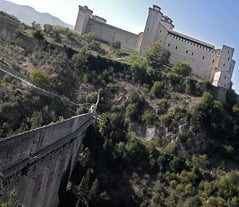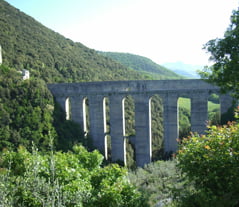 In a large gorge south of Spoleto, an imposing limestone bridge arises from a sea of lush vegetation. The precise, man-made structure juxtaposes with the wild, organic flora that surrounds it to create a breathtaking panorama unforgettable to those who have the chance to admire it. Spoleto’s Ponte delle Torri (Bridge of Towers) is not only the most iconic symbol of the city, but for centuries it has been an inspiration to countless poets and artists (from famed German writer Johann Goethe to British landscape painter J.M.W. Turner, and many more).
In a large gorge south of Spoleto, an imposing limestone bridge arises from a sea of lush vegetation. The precise, man-made structure juxtaposes with the wild, organic flora that surrounds it to create a breathtaking panorama unforgettable to those who have the chance to admire it. Spoleto’s Ponte delle Torri (Bridge of Towers) is not only the most iconic symbol of the city, but for centuries it has been an inspiration to countless poets and artists (from famed German writer Johann Goethe to British landscape painter J.M.W. Turner, and many more).
Historians are in disagreement regarding the exact date of this momentous bridge’s construction, but the general consensus is that the current structure dates back to the end of the fourteenth century, and it was most likely built upon the remains of a pre-existing Roman aqueduct. The bridge is composed of ten arches and spans a height of roughly 250 feet and a length of 750 feet, though its initial dimensions are believed to have been much larger. Originally, Ponte delle Torri served two functions: as an aqueduct to direct water from the mountains to Spoleto and as a bridge to connect the Sant’Elia Hill (where Spoleto’s historical city center is located) to the hamlet of Monteluco. It is worth mentioning that the entire bridge can be crossed by foot and many visitors take advantage of this to admire beautiful panoramas from Ponte delle Torri’s remarkable height.
Two fortresses can be found at either ends of the bridge. On the side of the Sant’Elia Hill one will find Rocca Albornoziana, a fortress designed in 1359 by an architect from Gubbio named Matteo Gattaponi. On the other side is Fortilizio dei Mulini, a fortress that, like the bridge itself, served a dual purpose. Not only did it function as a mill to produce grain, but it also functioned as a watchtower tasked with protecting the city of Spoleto during medieval times. 
The origin of the bridge’s name is contested, but one popular theory connects the name to the presence of watchtowers on both ends of the bridge. Another theory suggests that the name alludes to the nine large pillars that constitute the bridge’s arches. A third theory is even more specific, suggesting that the hollow interior of the two central pillars is due to the fact that they functioned as guard towers, and it is from here that the name derives.
Recently, efforts have been made to protect the bridge from the seismic activity that plagues much of Italy. In February of 2015, ENEA (Italy’s national agency for new technology and energy) developed a monitoring system specifically for Ponte delle Torri. The system is based on prior technology used in other parts of Umbria such as Orvieto to detect cracks in the city’s stunning Cathedral. ENEA aims to use satellites, structure samples, and drones to assess Ponte delle Torri’s susceptible areas.
Today, Ponte delle Torri continues to function as a bridge connecting Spoleto and Monteluco. It attracts visitors from all over the world thanks to its fascinating appearance and the stunning views it provides of the pristine areas surrounding Spoleto. Many visitors enjoy simply walking across the bridge and taking in as much of the natural surroundings as possible.